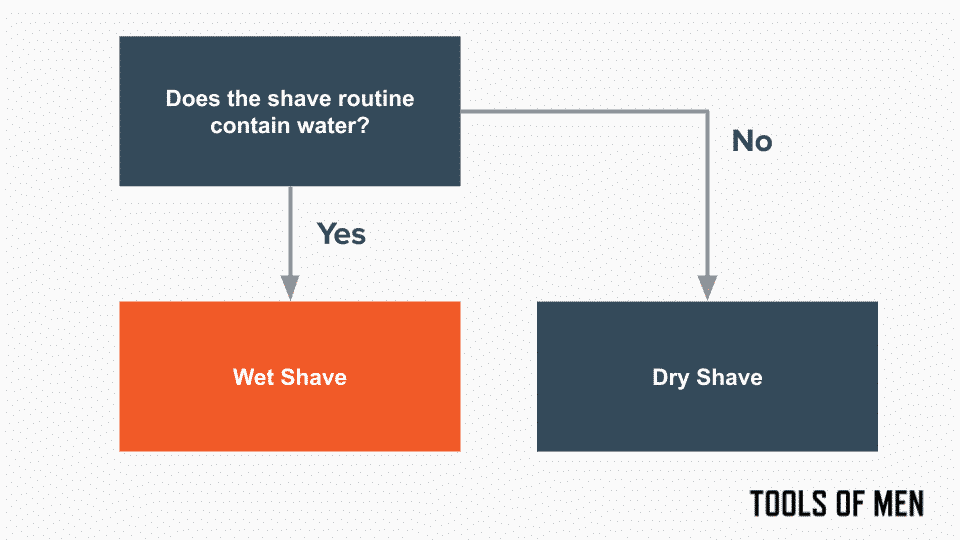Wet shaving can have a lot of different meanings for men. Some may interpret it as a traditional old-school barbershop shave. In contrast, others may interpret it as simply using a modern electric shaver with shaving cream – truth be told, both of these interpretations are technically correct.
Wet shaving is defined as when water is added to the shaving routine. This is often added in the form of shaving cream, shaving soap, or shaving oil.
Here’s a diagram:

What types of razors are used for wet shaving?
While we highlight all the different types of razors in this post, folks commonly use the following in a wet shave:
- Straight razors & shavettes: These are single-blade razor that is used with shaving soap or cream.
- Double edge safety razors: A modification of the straight razor that has one cutting edge on either side of the head.
- Cartridge razors: This will be your modern-day Gillette or Schick razor that relies on an interchangeable cartridge.
- Electric razors: The compatibility varies on the model; some are capable of being used with shaving cream, while others are not.
Do you always have to use water?
When you moisten your skin and hair with water prior to shaving, the skin becomes supple and pliable while the hairs significantly soften to make them easier to cut. The addition of shaving cream or soap provides additional lubrication, allowing the blade to glide on the skin while cutting the hair.
Shaving without water or shaving cream on dry skin increases the risk of irritation and cuts. The blade may also skip along the surface, requiring multiple passes.
But don’t people dry shave?
Yes, some barbers may use a shavette to define precise lines, particularly to shape and develop a good-looking beard. To do this, they will often pull the skin taut and shave with the grain. The amount of hair being shaved is limited, resulting in less irritation.
The only time when it is generally acceptable to perform a dry shave regularly would be with an electric razor. These tools perform better on dry skin as they are easier to trim hair. Additionally, using an electric razor in a dry environment should lead to fewer ingrown hairs.
Wet vs. dry shaving
To summarize, here’s how these two methods of shaving differ from one another:
- Wet shaving: Requires the use of water and, in most instances, shaving cream or soap to prep the skin before shaving.
- Dry shaving: Acceptable for electric razors or when defining lines of a beard. Dry shaving the face or elsewhere on your body is likely to result in irritation and cuts.
How does this all relate to traditional wet shaving?
When visiting shaving forums, be it Badger & Blade, Reddit’s /r/wicked_edge, or another shaving community, traditional wet shaving is often defined as using a straight razor, shavette, or safety razor, essentially an older shaving tool. Furthermore, other products, including shaving brushes, aftershaves, and pre-shave oils, are added to the shaving routine to provide better and more comfortable results while also enhancing the shave experience.
Shaving supplies used by traditional wet shavers tend to be more natural, organic, or better developed to complement the shaving tools they are used with. With the exception of Barbasol, you won’t see modern canned shaving creams used here. Instead, you’ll find shaving soaps, shaving creams, and shaving oils that are full of ingredients like tallow, lanolin, shea butter, various carrier oils, and more.